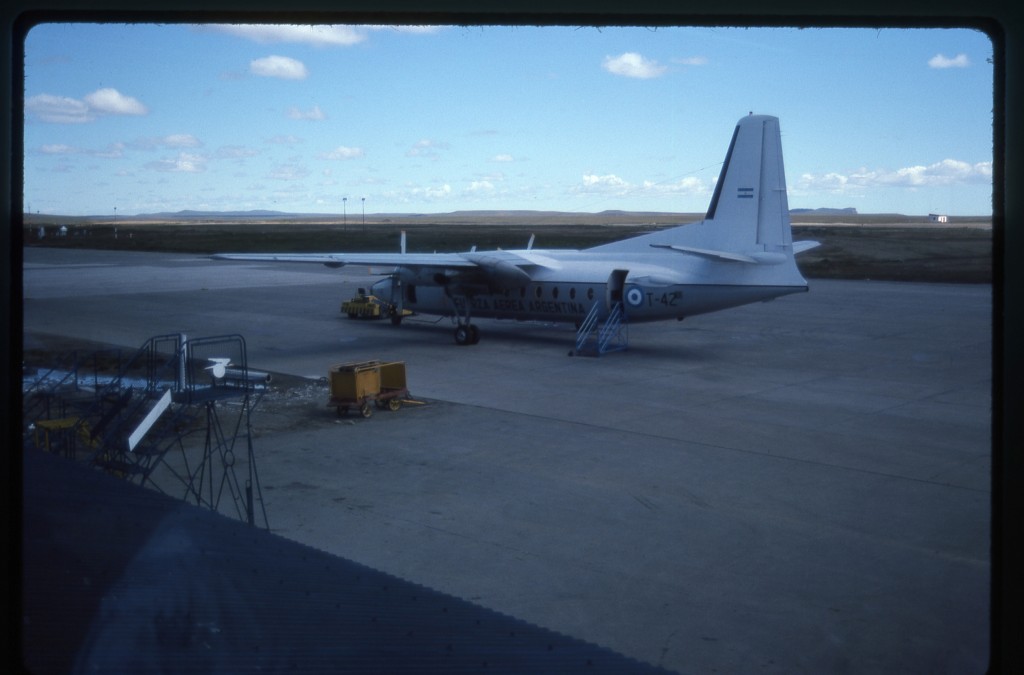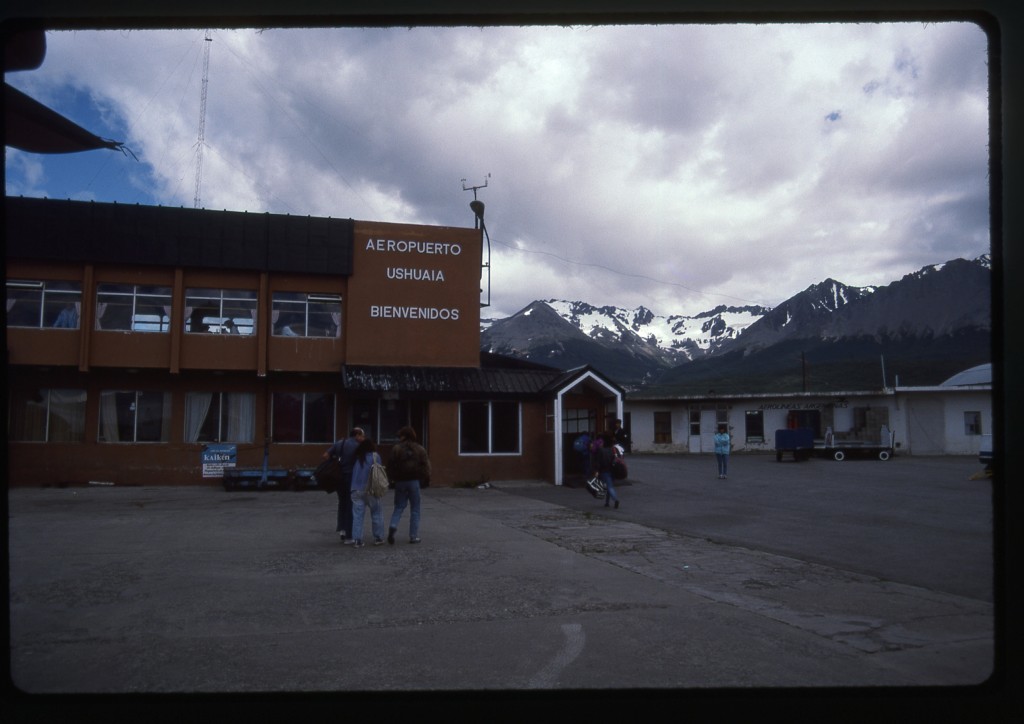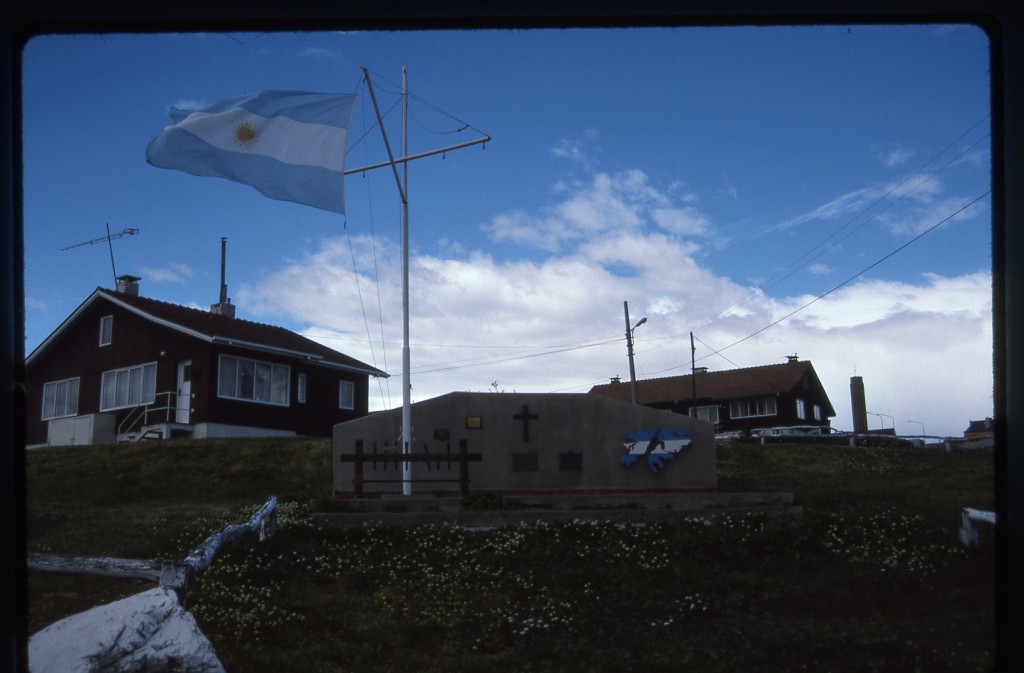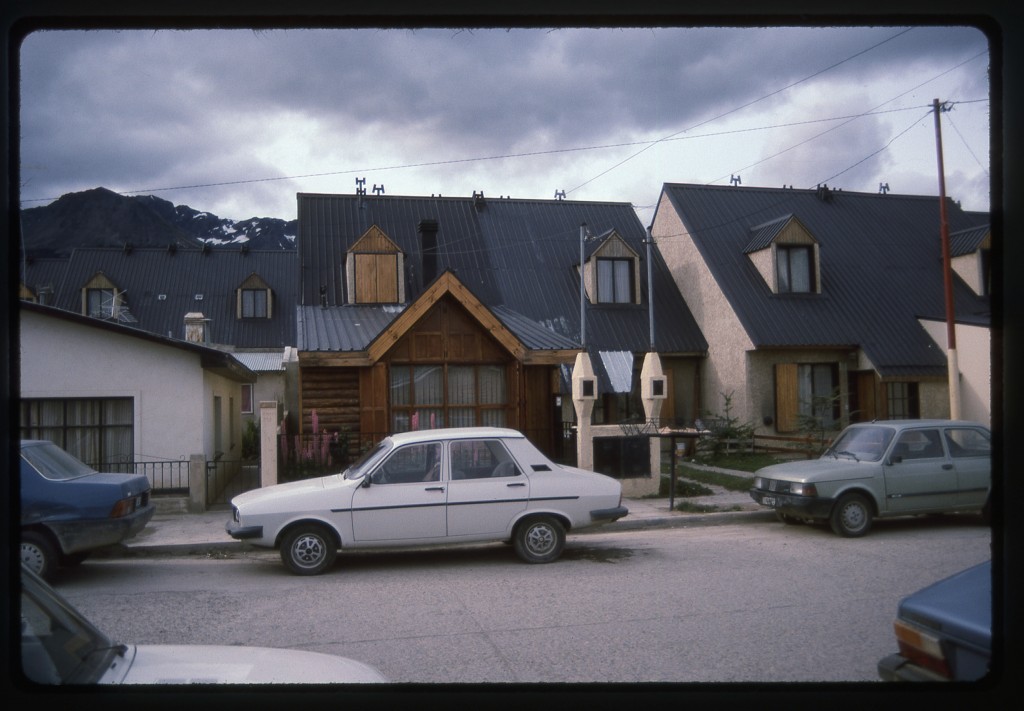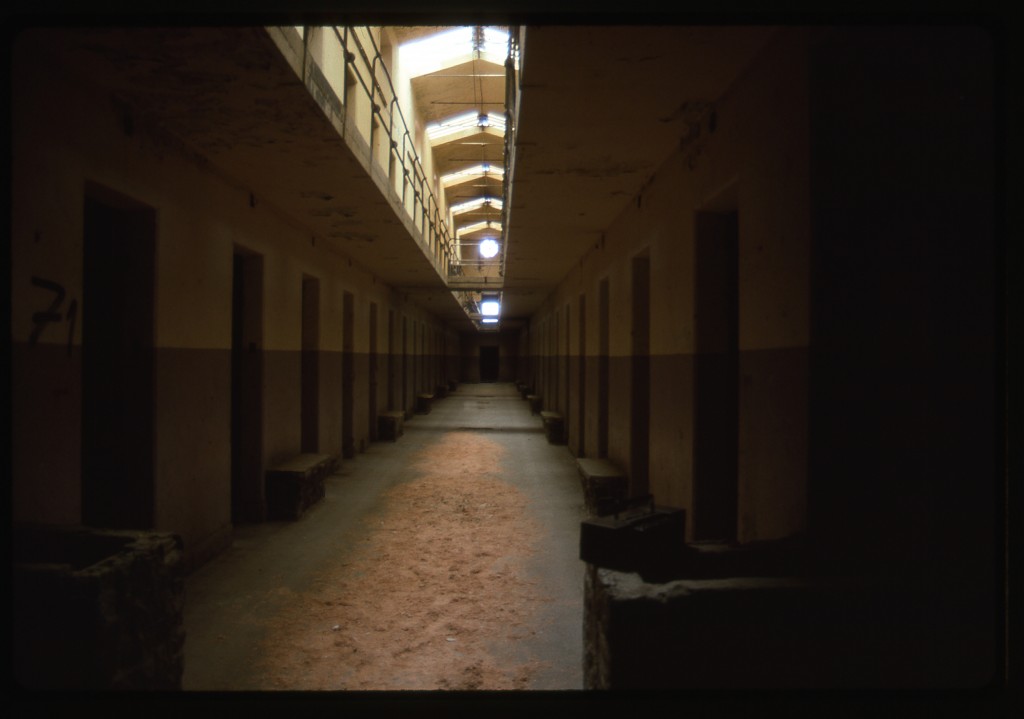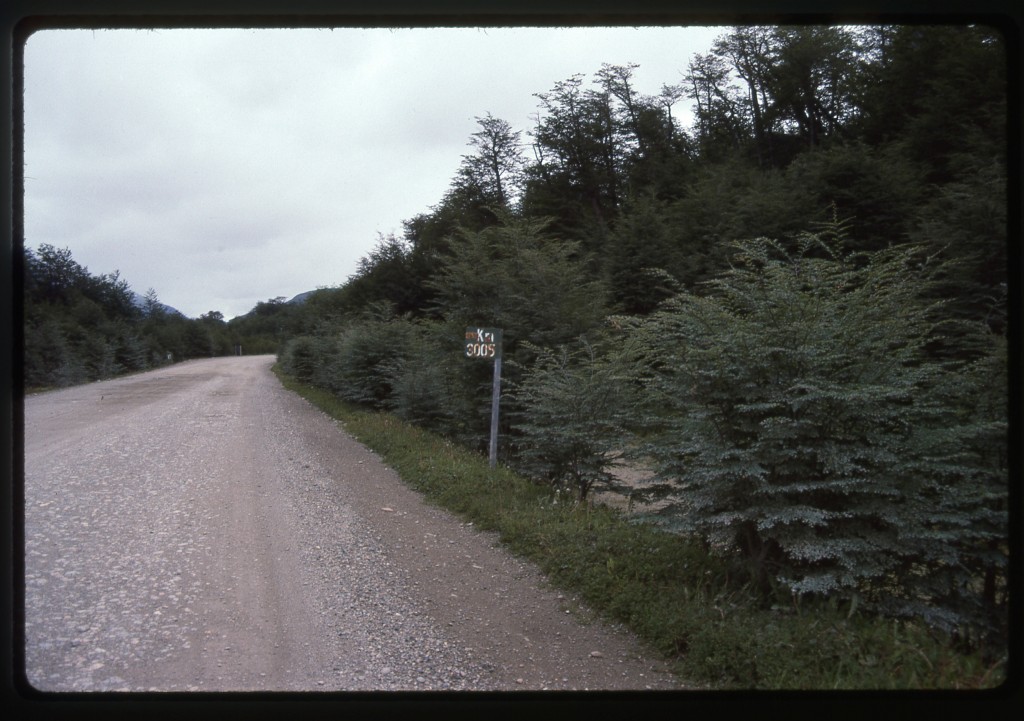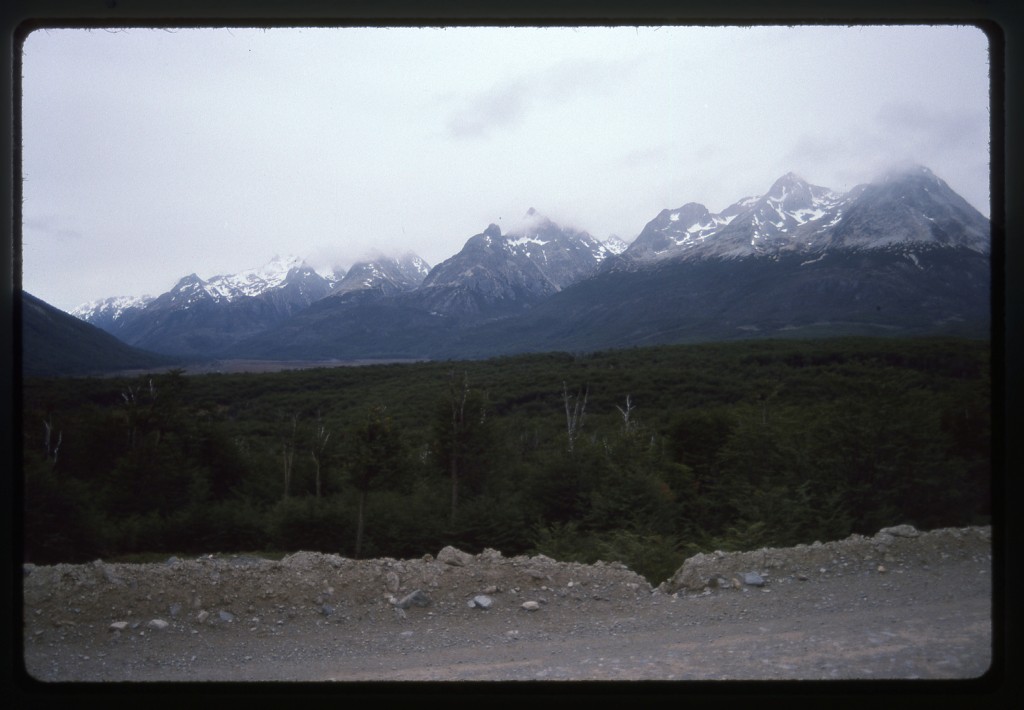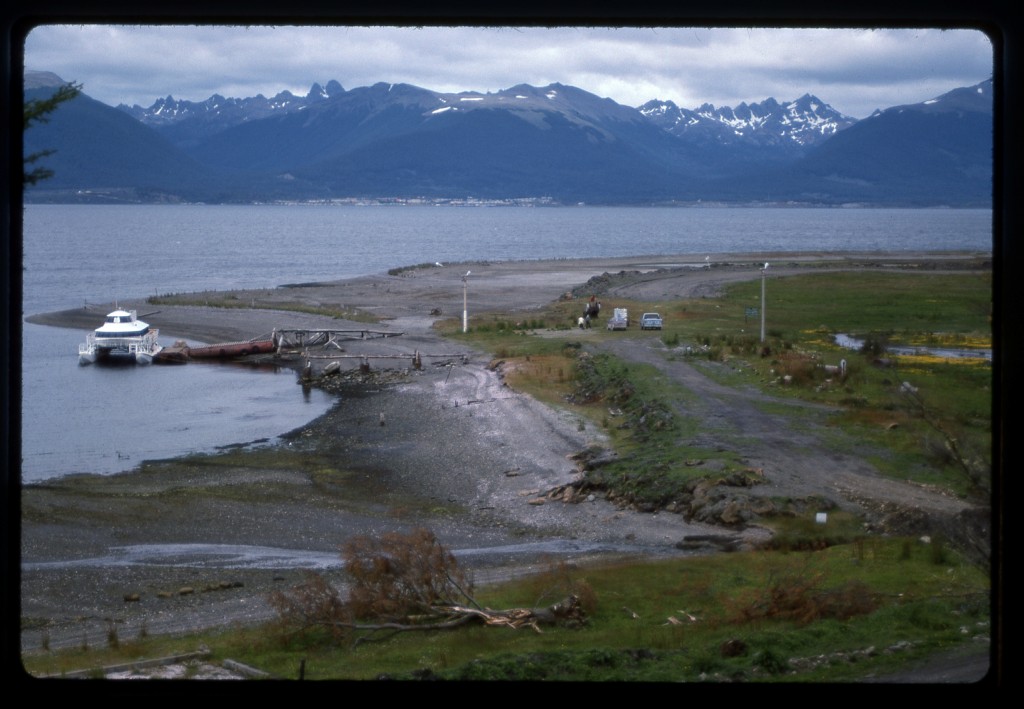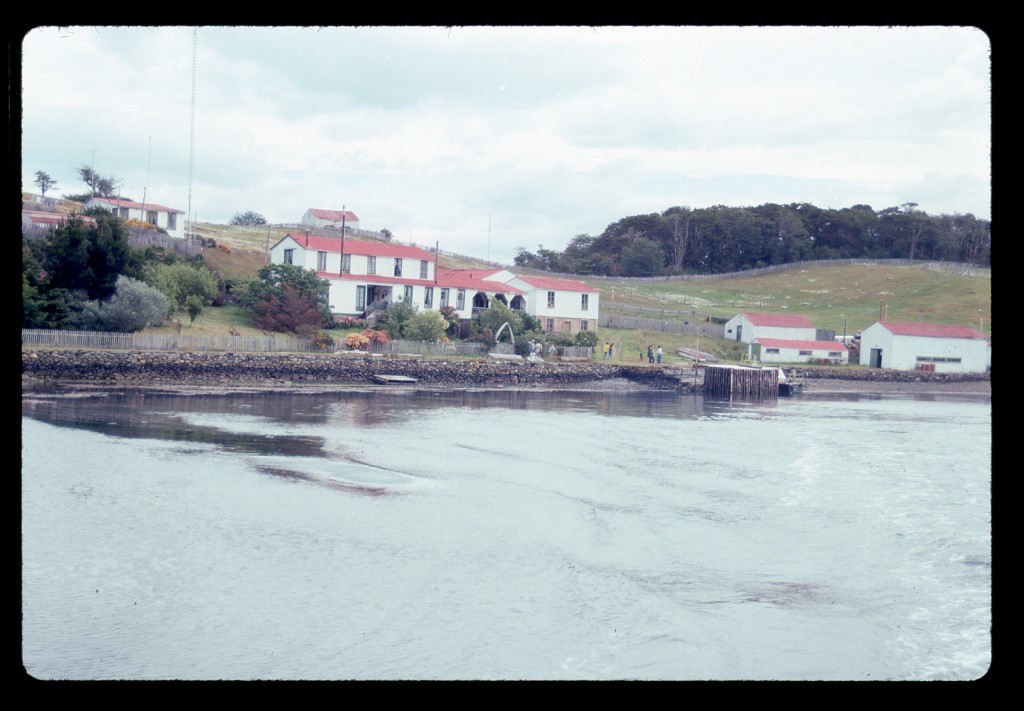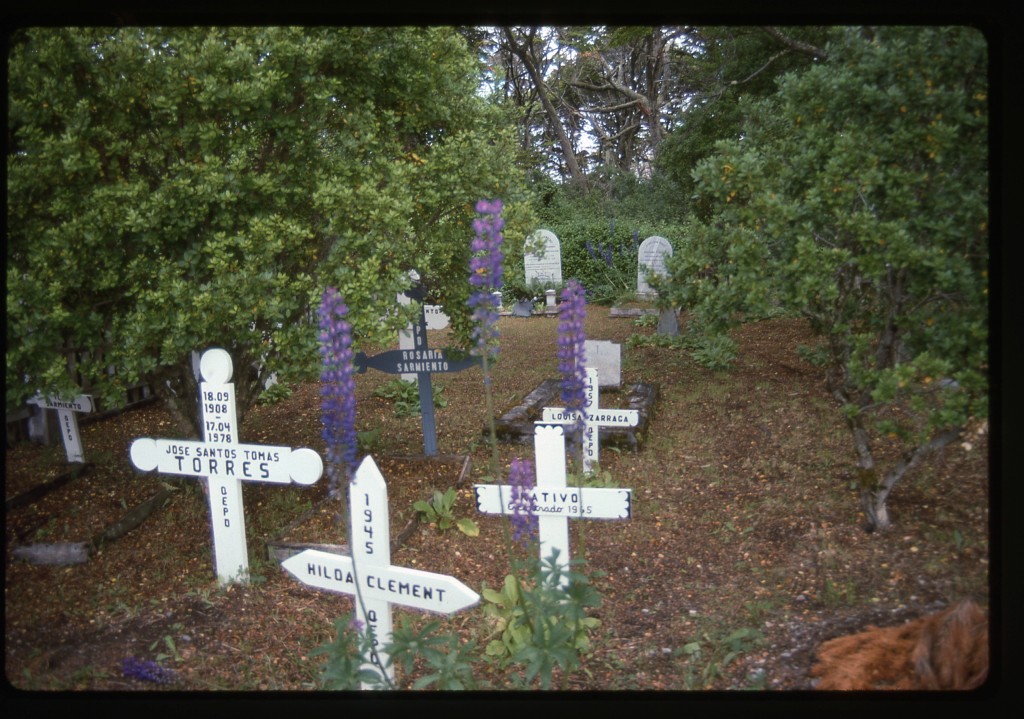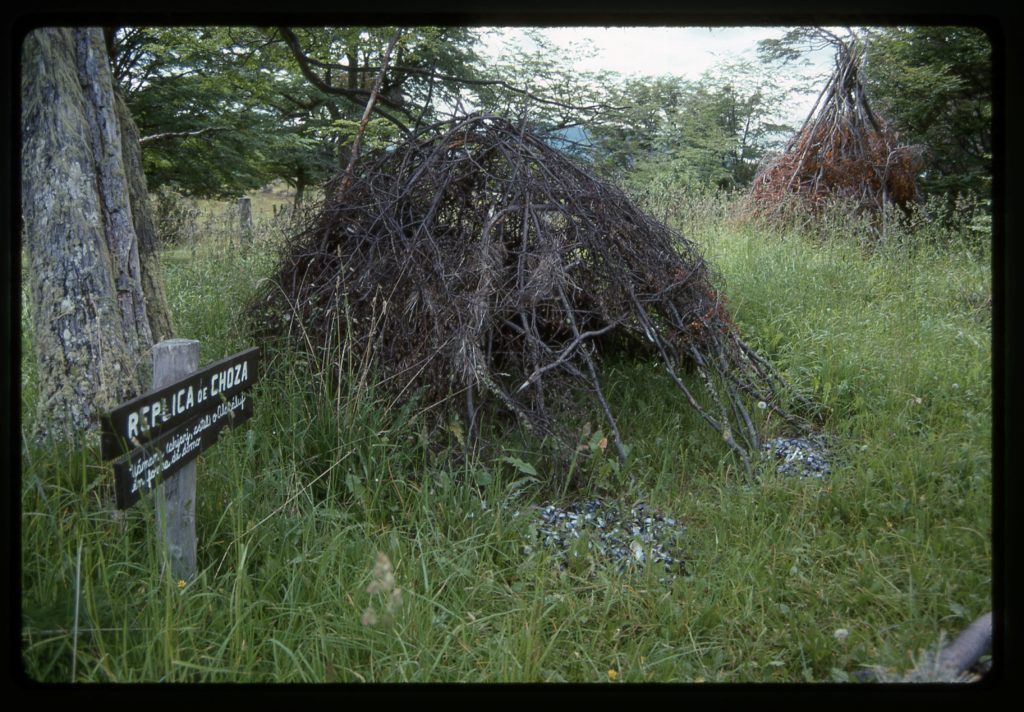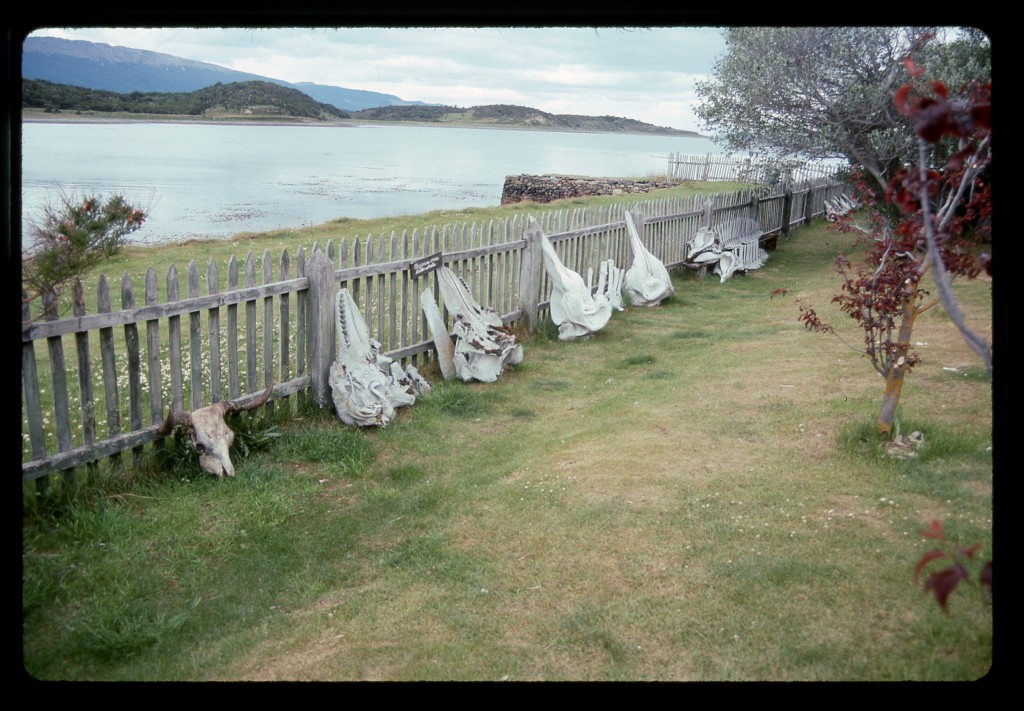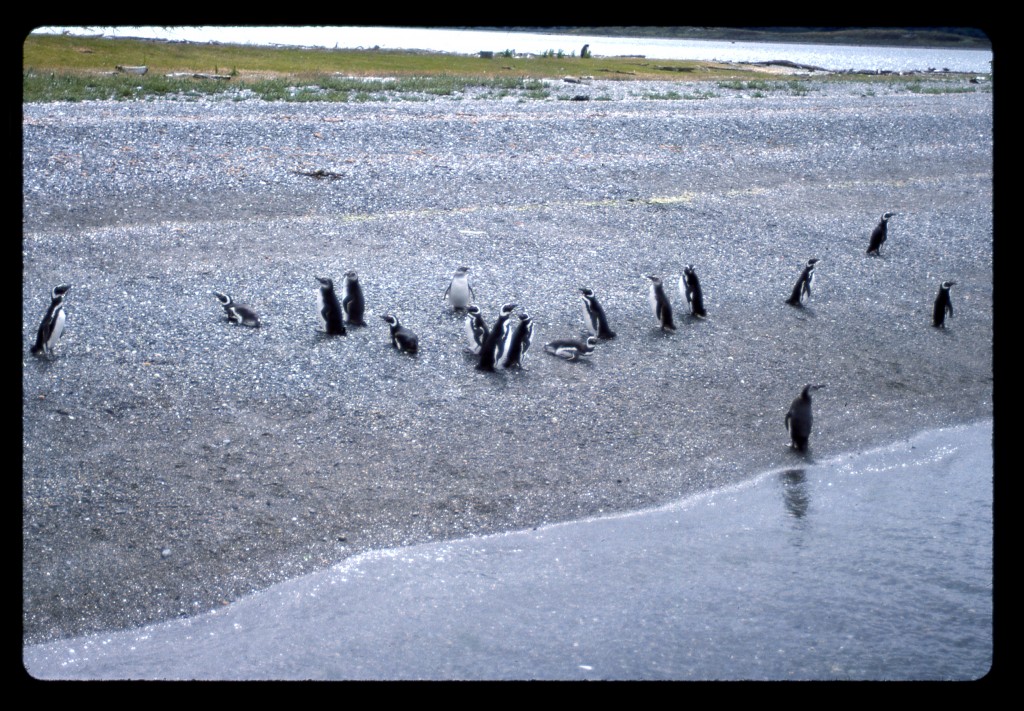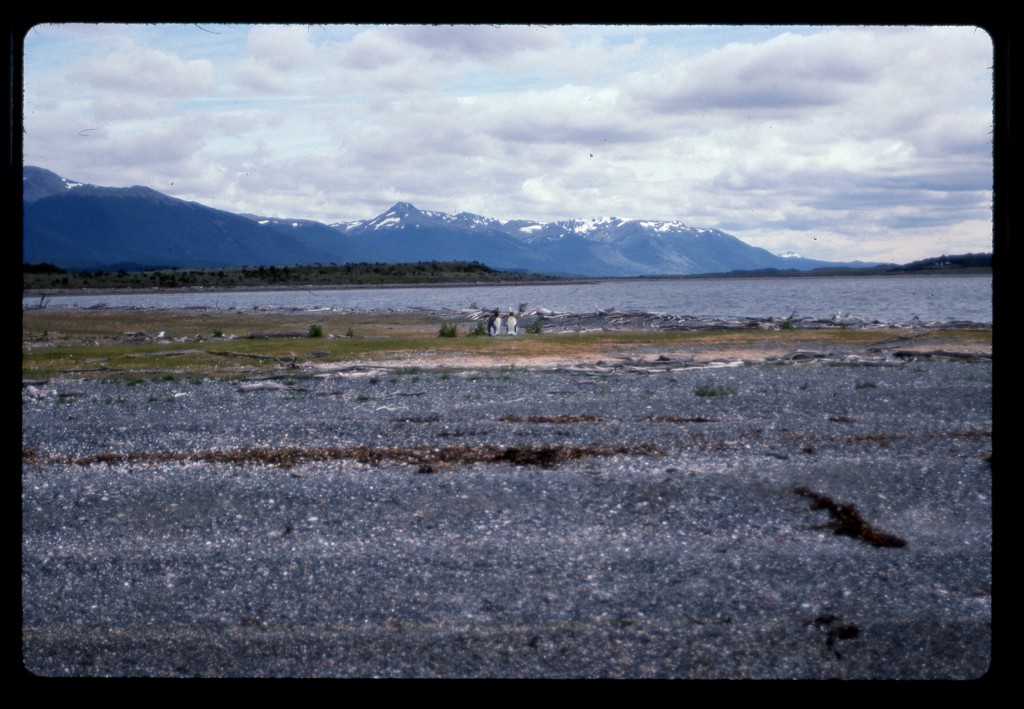To get the most from this story, please be sure you’ve read the previous 8 parts already posted on this website.
Sunday, January 13, 1991
The big day had finally arrived – I was going to fly to the bottom of the world. Ushuaia was the southernmost city on the planet, and until now it had just been a name on a map in my world atlas – it was terra incognita to me. I awoke at 4:00 AM, allowing myself plenty of time to get my things ready, then walked into the street and caught a cab for a 40,000A ride to Aeroparque, the airport in Buenos Aires which handles domestic flights. I boarded my Austral jet and settled in for the ride. Even though there would be a few stops en route, the entire flight to Ushuaia only counted as one of my eight tickets in the tourist package of flights I had purchased.
The first leg was a three-hour flight: much of the first half was over the Atlantic coast; the rest of it was over endless miles of barren, empty land. We landed at Río Gallegos, a city of 100,000 which is the capital of Santa Cruz province. It’s not exactly a talked-about tourist attraction, so few travelers go out of their way to visit. A busy port it is, though – much coal ships from here. There’s an oil refinery, and the wool from a bazillion sheep raised out on the endless fields of Patagonia passes through here. And it’s always cold and windy, even in summer. Oh yes, one more important thing about Río Gallegos – it was a base of operations for the Argentine military during the Falklands war.
I stayed on the plane, but found myself sitting beside a lady lawyer for the next leg, a 40-minute flight to the city of Río Grande. This city is the capital of the province of Tierra del Fuego, and boasts a population of about 70,000 hardy souls. Hardy because even in the austral summer, the temperature barely cracks 60 degrees F. on a warm day. Río Grande sits on the Atlantic coast on the northeast corner of Isla Grande of Tierra del Fuego. The conversation with my new lady friend was so engaging (she was offering me names and phone numbers of herself and her friends around the country who would gladly offer help if I needed it during the rest of my travels) that when we touched down, we were talking through the announcements and I missed the fact that I needed to de-plane and board a different one. At the last moment, just before the plane was about to head back north to Buenos Aires, we realized it and they hurried me off – it was hilarious and outrageous and a bit scary.
Into the little terminal I went, where they gave me a new boarding pass for the plane to Ushuaia. Forty-five minutes I waited – the view outside showed a chill, barren, bleak and treeless landscape. Our plane pulled up – an old Fokker twin-prop 40-seat plane which appears to have been borrowed from the Argentine Air Force.
Once aboard, we flew for an hour over endless miles of rugged alpine country, with a lot of ice and snow above treeline – it was exciting and I loved every minute of it.
The airport at Ushuaia is one of the trickier ones at which a pilot can land. It sits at the foot of rugged peaks which tower over 4,000 vertical feet above it. so when our plane crested these peaks, it had to drop precipitously in a short distance to get down to the runway at sea level. Some pilots didn’t exactly ace the landing, such as this one in 1988. In fact, one of the passengers in the 1988 crash was from my home town of Tucson, Arizona – she said it was a terrifying event. We did manage to land without incident, although it was exciting to drop so far in only a few minutes.
I was traveling with a small backpack, a carry-on, so I could de-plane quickly. What a surprise when I left the plane and walked across the tarmac to the small terminal – it was downright chilly. High temperatures in January here, in the middle of the summer, average in the mid-50s F. A day with a high of 70 degrees F. is almost unheard-of. Inside the terminal, I put on some warmer clothes, then walked into town – it was a couple of miles, and I had no luck hitching a ride. Along the way, I passed this memorial to the war dead in the Falklands, or, more properly in these parts, Las Malvinas.
Once into the city, I learned of a hospedaje, walked there and knocked on the door but found nobody home. Needing a place to stay, I then headed to the main street. Two Germans, Mike and Peter, crossed my path and we talked – turned out that they had a double at a hotel and were agreeable to split it three ways. For 73,000 Australes, I was now in the best room I’d had in five weeks in Argentina. The guys were leaving town the next day, though, so I needed to find another arrangement, and soon.
Since I’d probably never again be here at the bottom of the world, I made a list of several things I really wanted to do in the week I’d have – these were the most important items on the list:
1. Cross the Beagle Channel to visit Puerto Williams, a Chilean navel base 2.Visit Cape Horn, the southernmost tip of South America, about 60 miles away 3.Visit by boat some of the islands in Beagle Channel 4.Do some climbing
I’d need to try like hell to get as much done as I could in the short time I had. After a good night’s sleep, I bid farewell to Mike and Peter, both sports writers for a major newspaper in Frankfurt. Needing information, I went to talk to the folks at Rumbo Sur, a local travel agency, to ask them about my bucket list – the news was not good. There was no touristy way to get to Cape Horn. As for Puerto Williams, there was a boat which went every Saturday, the complication being that they didn’t go unless it was full enough, and that hadn’t happened but once in the last two months.
My next stop was the local tourist bureau, which steered me to the home of a family who had a room to let in their own home. I went to check it out, and found the Craboleda family to be very congenial. They led me upstairs to a modern, comfortable bedroom with two single beds. For 60,000 Australes, it was a good deal for Ushuaia, so I grabbed it.
After unpacking, I walked into town and played tourist, buying souvenirs and doing a walkabout. Someone steered me to a museum, where I met a couple who had driven here from New Mexico (minus the Darien Gap, of course). En route, they had climbed Cotopaxi, which turned out to be the first peak they had ever climbed – pretty impressive. But even more impressive was their friend, an Aussie girl, who had quite the story to tell. Her boyfriend had talked his way on to a Chilean navy vessel headed to Antarctica to service all eleven of their bases on the Antarctic Peninsula. He’d paid $1,200.00 US for the 3-week trip, an incredible bargain, and she was hanging out until his return.
I’d heard that a visit to the old Ushuaia Jail was worthwhile, and it didn’t disappoint. When I was there, it was a cold, frightening place, and although fascinating, I was happy to leave.
One thing I really enjoyed about this town was that I walked everywhere, miles each day, exploring every nook and cranny. I’d find an interesting place for supper and then ice cream afterwards, one of the few indulgences I allowed myself.
Tuesday, January 15, 1991
Today I played tourist. After paying a travel agent for a tour, I boarded a bus and we headed out of town on Ruta Nacional #3, a gravel highway. The day was overcast and chilly. The signpost says KM 3005, which means this spot is 3,005 kilometers from Buenos Aires.
I paid special attention to the mountains as we rode along. Treeline was about 2,000 feet, and although the mountains in this area were only 3,000 to 4,000 feet, all of them had snow and some had glaciers.
The bush was pretty solid, and there were rivers running everywhere. After a few hours of driving around, we stopped at Refugio Almanza for a lunch break. While the others went inside to eat, I walked outside, munching on my sandwich. This spot was across the Beagle Channel from Puerto Williams, as this next photo shows. Behind the navy base on the distant shore rise the peaks of Isla Navarino, rising to the high point at 3,921′. Also visible are the jagged Dientes de Navarino. A hiking circuit around the island exists, requiring 5 to 7 days to complete. Rock climbing areas can also be found on this island, which boasts the southernmost permanent settlements on the planet – Antarctica doesn’t count, as theirs are all research stations.
Our tour continued, driving a dozen miles more to Estancia Harberton. This place had the distinction of being the oldest ranch on Tierra del Fuego (1886), the most southerly ranch in the world, and the home to 50,000 sheep. We toured the buildings, garden and the family home.
The ranch even had its own cemetery, with graves dating back many years.
Another really cool thing at the ranch was this re-creation of a typcal Yaghan shelter. This was the world’s southernmost people, and they arrived on the Isla Grande of Tierra del Fuego 10,000 years ago by a now-submerged land bridge. Here is a fascinating link which will tell you a lot about this amazing culture.
This next photo shows a remnant of the old whaling days from this area.
We then took a catamaran ride (very nice and comfy) which allowed us to see penguins on the shore of a couple of islands. There were a lot of Magellanic penguins, as seen in this photo.
Our guide on the boat became excited when he spotted two King penguins a bit farther off. As a birder, I was pretty excited too. In this next photo, they are in the distance, but you can zoom in a lot and see the orange markings on their neck. Kings are the second-largest species, second only to Emperors in size.
When our boat docked, the bus was waiting, and before we knew it we were back in Ushuaia. By the time I’d bought a few groceries and walked back to my room, I discovered I had a room-mate – Seadon, from Colorado Springs. No worries, he seemed like a nice guy.
It was time to go climb something, and tomorrow was the day. I was excited to get a taste of Tierra del Fuego’s mountains.
Please stay tuned for the next installment of this story, Part 10.
Please visit our Facebook page at https://www.facebook.com/pages/Desert-Mountaineer/192730747542690

